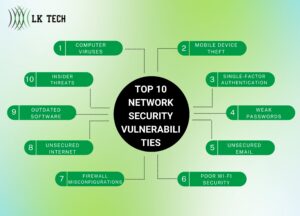Top 10 Network Security Vulnerabilities And Solutions
Recent data shows a 28% global increase in cyber attacks in 2022, highlighting the need for robust network security, especially for companies handling sensitive customer data. As cybercriminals get more sophisticated, no business is immune from threats. Small businesses to large corporations face growing risks that can damage operations, finances and reputations if networks have vulnerabilities. Below we explore the most common network security threats that leave data exposed and provide comprehensive ways to safeguard your business.

Top 10 Network Security Vulnerabilities And Solutions
Top 10 Network Security Vulnerabilities
1. Computer Viruses
Computer viruses that spread malicious code remain a prevalent threat, evolving over time to exploit new vulnerabilities. Viruses like trojans, worms, and spyware infect systems in various ways, from emails to infected websites. Once in a system, they can delete or encrypt data, slow operations, or secretly gather sensitive information. Anti-virus software is essential, but not foolproof as new viruses emerge constantly. Ongoing user education helps, teaching employees to avoid opening suspicious emails and links. Restricting software installations and website access limits infection risks too. Cross-site scripting is another virus danger where criminals inject malicious code into trusted websites to trick browsers into running harmful scripts. This enables data and login credential theft. Robust malware protection that detects viruses combined with vigilant network monitoring provides vital safeguards.
2. Mobile Device Theft
As workforces go mobile, lost or stolen phones and laptops become easy gateways for data compromise. Whether left behind in airports, taken from cars, or misplaced, mobile devices get into the wrong hands too often. If not secured properly, thieves can easily gain access to business contacts, emails, documents and more. Criminals with enough technical savvy can access mobile device contents and settings without the authorized user even knowing. This allows remote data wiping, lockouts, and other problems. Stringent mobile device security is crucial for today's dispersed workforces. IT partners like LK Technologies employ advanced mobile device management software to oversee each device from one centralized platform. This allows remote location tracking, data wiping, access restrictions and other vital protections if a device gets lost or stolen. Proper encryption also helps secure data if devices fall into the wrong hands. For ultimate security, companies should restrict file sharing across mobile devices and implement secure Wi-Fi networks to prevent criminals from intercepting mobile data.
3. Single-Factor Authentication
Reliance on single-factor authentication (SFA) like passwords leaves networks extremely susceptible because SFA is easy to crack. SFA depends on just one entry point, usually a password, to verify a user's identity and grant system access. The problem is that passwords get stolen through phishing scams, guessing, and hacking attacks. Once a criminal learns someone's password, they have full access. Multi-factor authentication (MFA) closes this glaring vulnerability by requiring 2 or more credentials to verify users. MFA could involve a password plus a unique code texted to a user's phone or a fingerprint scan. Even if one factor gets compromised, others still protect access. Leading IT experts consider MFA a mandatory security practice today, especially for companies handling financial data, healthcare records and other sensitive information. Though MFA adds process steps, the enhanced protection is worth the minor inconvenience.
4. Weak Passwords
Using weak passwords continues to be a top security vulnerability. Despite warnings, many people still use easy to guess passwords like "password123" or common words and dates. These provide easy access for automated hacking programs that can run password combinations until cracking accounts. Strong passphrases thwart these brute force programs and should be company policy. Expert tips for creating strong passphrases include:
- Use at least 12 characters
- Combine random words with numbers and symbols
- Avoid common phrases and personal info
- Change passwords every 90 days
- Use different passphrases across accounts
- Consider using a password manager app to generate and store secure passphrases
IT partners can run password strength audits and require enhancements to meet security standards. Employee training is also key to ensuring proper password protocols across an organization.
5. Unsecured Email
Email remains a top digital communication tool, making it a prime target for phishing scams aiming to steal financial data and credentials. These sophisticated scams use social engineering techniques to craft convincing emails that appear legitimate. Email security that relies solely on employees identifying phishing attempts has proven woefully inadequate. Robust technical protections are essential, like gateways that filter out dangerous email attachments and links. Security awareness training helps alert employees to phishing red flags as scams get harder to spot. However, even well-trained staff get duped, underscoring the need for multilayered email security. Encrypting email in transit and at rest protects communications that could expose confidential data if intercepted or stored on insecure networks. As phishing ploys advance, securing email must be a top priority to avoid compromised accounts, networks and data.

Top 10 Network Security Vulnerabilities And Solutions
6. Poor Wi-Fi Security
Public Wi-Fi networks at coffee shops and other businesses often have outdated routers and unchanged default settings that make it easy for nearby criminals to access connected devices and activity. Private networks also face risks if internal Wi-Fi isn't adequately secured. Encryption and password protection are basics, but Wi-Fi security goes much deeper in today's threat landscape. Network monitoring helps detect unauthorized users and abnormal behaviors that could signal breaches. The latest WPA3 Wi-Fi security protocol adds robust encryption and authentication for maximum safety. Proper router maintenance ensures timely firmware updates are applied when manufacturers identify new vulnerabilities. IT partners provide ongoing Wi-Fi security management to identify gaps and implement solutions like client isolation and blacklisting. For companies with multiple locations, choosing a unified platform to oversee all sites ensures consistent Wi-Fi protection.
7. Firewall Misconfigurations
Firewalls remain essential defenses, using rules to restrict unauthorized network access. However, they require ongoing analysis and maintenance to ensure proper set up. Even minor misconfigurations in port settings, protocols and other parameters create security holes that attackers exploit. The complexities of modern networks and workforces make it easy for firewall gaps to arise. Complacency also breeds misconfigurations as companies fail to regularly update firewalls to address new threats. IT solution providers like LK Technologies offer managed firewall services, monitoring rules and activity 24/7 to identify and remedy misconfigurations before criminals infiltrate networks. For cloud environments, improperly configured cloud firewalls are another vulnerability.
8. Unsecured Internet of Things (IoT) Devices
The growing Internet of Things (IoT) - web-connected smart devices, appliances, sensors and more - introduce new network access risks if not properly secured. IoT devices often gather and transmit sensitive data that could expose networks if intercepted or hacked. Their distributed nature and frequent remote access capabilities provide criminals more potential entry points. Yet many smaller IoT devices lack robust security capabilities on their own. This makes comprehensive IoT security strategies essential, especially for healthcare, manufacturing and other industries deploying connected technologies. IT experts recommend creating a full IoT device inventory to identify each one on your network. This allows segmenting IoT devices on their own networks, tightening access. Monitoring network traffic from IoT devices helps detect abnormal transmissions that could signal a breach. Many IoT vendors offer security features like encryption that companies should enable. As criminals increasingly target IoT networks, proactive IoT security is a must today.
9. Outdated Software
Using outdated operation systems, applications, and network infrastructure leaves organizations vulnerable. Vendors constantly update software to address emerging threats. Failing to regularly install patches and new versions allows preventable access points. The Equifax breach that exposed over 140 million consumers' personal data resulted from failing to update a known Apache Struts vulnerability. Regular monitoring and updating is essential. Most software includes auto-update options that should remain enabled. IT partners help companies maintain diligent update protocols across systems, keeping everything current. For larger organizations this requires automated tracking and deployment tools. Updates apply to network devices too, like routers, switches and firewalls. The log4j vulnerability in the popular Java logging library demonstrates how a single outdated component can devastate network security. Make timely software and infrastructure updates a top priority.
10. Insider Threats
While external hackers pose significant dangers, insider threats from employees and partners should not get overlooked. Insiders with authorized access can intentionally or accidentally expose data and systems in many ways. Intentional threats include disgruntled employees stealing and selling data or sabotaging systems. Accidental insider threats result from mishandling data, falling for phishing scams, using weak passwords, and more. Restricting access to only essential personnel helps limit insider risks. Monitoring systems for unauthorized usage patterns also detects problems. Ongoing staff training builds security awareness - make it clear that policy violations have consequences. IT partners use behavioral analytics and machine learning to spot odd usage that could indicate insider threats. Proper controls make it difficult for anyone to access sensitive data repositories. Insider threats require nuanced prevention strategies focused on limiting access, building trust and training.
Partner With LK Technologies for Robust Security
LK Technologies, a leading Cincinnati IT services provider, helps businesses assess vulnerabilities, implement layered security protections, and monitor networks around the clock to prevent threats. Their expertise includes IT infrastructure, cybersecurity, cloud solutions and more. LK Technologies starts with a network audit and risk analysis to identify an organization's unique vulnerabilities. Next they create a strategic security roadmap tailored to business needs and resources. Solutions include firewalls, intrusion detection, endpoint protection, access controls and other safeguards. Clients receive ongoing security management and monitoring to identify and thwart the latest threats. LK Technologies stays current on cybercrime trends, regulations, and technologies to keep clients secure. Their experienced team handles implementation and maintenance so companies can focus on daily operations rather than cybersecurity intricacies. For proven local expertise that provides end-to-end security, partner with LK Technologies.
Conclusion
Today's expanding networks face evolving threats from viruses, phishing scams, device theft and even trusted insiders. Understanding the most common vulnerabilities is the first step toward tailored safeguards. Partnering with a proven IT security provider like LK Technologies ensures robust defenses using the latest tools and techniques. Their experts manage multilayered protections and monitor networks 24/7 to identify and respond to incidents. Security requires constant vigilance and adaptation as new threats emerge. With increasing high-profile breaches, companies cannot afford gaps that put sensitive data and operations at risk. A proactive security strategy anchored by a trusted IT partner provides the ongoing protection that businesses need to stay safe in today's threat-filled landscape. Prioritize comprehensive cybersecurity now to secure your company's future.


